Ww2 Us Army Group Sterling Silver Cib-senior Jump Wings Medals-jump Patchs Rare
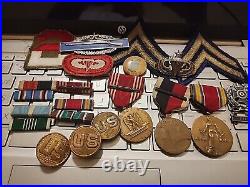
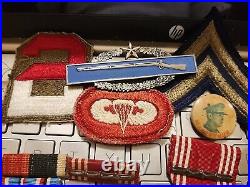




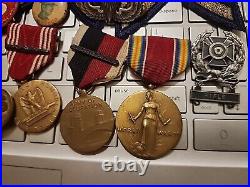
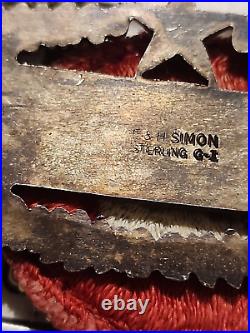
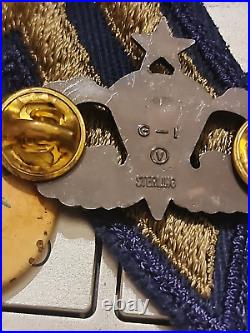
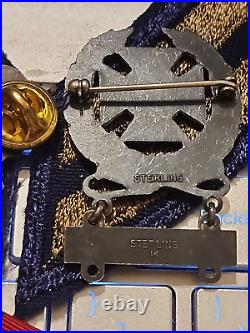
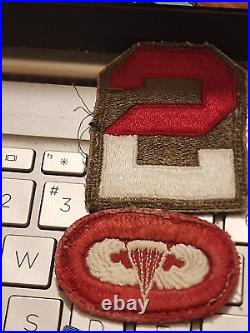
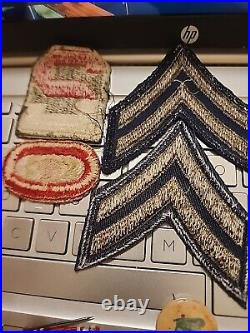
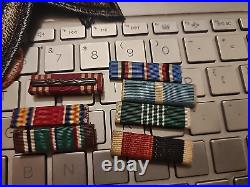




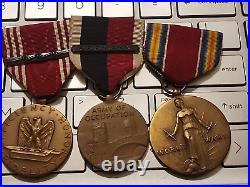

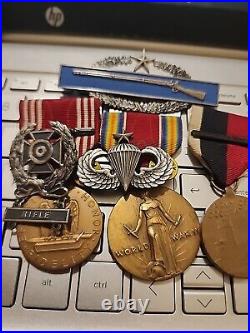
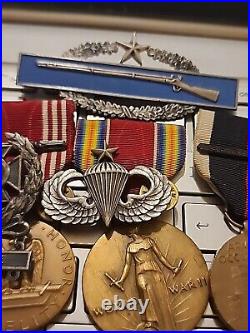
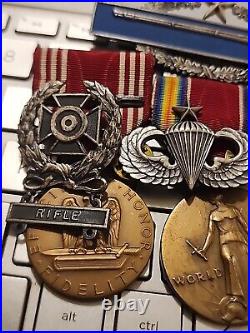
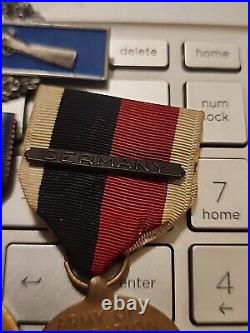
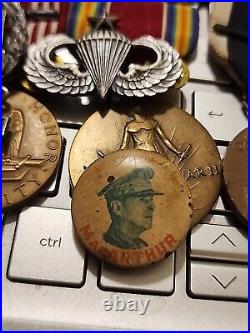

PLEASE FOLLOW OUR E BAY STORE. We do not want your feed back. We want your repeat business. We get that by posting new items. CIB, JUMP WINGS, MARKMAN BADGES. US Post WW2 German Made 503rd PIR Parachute Infantry Regt Jump Wing Oval. United States Army during World War II. The Army Goes Rolling Along. During World War II, the United States Army underwent significant changes and played a crucial role in the conflict, fundamentally shaping its purpose and structure. The primary objective of the U. Army during this period was to mobilize and deploy forces to combat Axis powers, including Germany, Italy, and Japan. This required a vast expansion of personnel and resources, leading to the largest military mobilization in American history up to that point.
In response to the war's demands, the Army implemented several reforms. The establishment of the Selective Service Act in 1940 allowed for the conscription of millions of American men, dramatically increasing the size of the Army from about 190,000 active-duty personnel in 1940 to over 8 million by 1945. Training programs were enhanced, and new units were formed, including specialized divisions like the Army Air Forces, which emphasized the importance of air power.
The Army also adopted more modern organizational structures and tactics, reflecting lessons learned from earlier conflicts. Innovations in strategy, logistics, and technology were prioritized to improve combat effectiveness.
The integration of women into the military through organizations like the WAVES (Women Accepted for Volunteer Emergency Service) and the WACs (Women's Army Corps) marked a significant shift in personnel policy, although racial segregation remained a prominent issue within the forces. At the beginning of the war, the Army and Air Force were under the command of the War Department, which in turn was subordinate to the President. The command structures were the same as those used during World War I. In 1940, there were six branches within the Army that were considered combat arms: Infantry.
And the Corps of Engineer. The War Department had authorized a General Headquarters, United States Army (GHQ) in 1921, but it was not activated until July 26, 1940.
Its purpose was to facilitate mobilization by overseeing the organization and training of the Army's field forces on the American mainland (Zone of Interior). In October 1940, the command of the corps areas was separated from the four armies that had been established in 1932. On March 17, 1941, the United States was divided into four defense commands that would become operational areas in the event of an impending invasion. GHQ was replaced by the Army Ground Forces on March 9, 1942. The four defense commands and all operational areas were transferred to the War Department General Staff.
General of the Army George Catlett Marshall. The US Army General Staff was the centerpiece of strategic planning and coordination. It consisted of several departments. G-1 (Personnel): Responsible for personnel management, recruiting and troop strength. G-2 (Intelligence): Responsible for gathering and analyzing intelligence on the enemy. G-3 (Operations): Coordinated the planning and execution of military operations. G-4 (Logistics): Focused on supplying troops with supplies and equipment. The head of the US Army was the Chief of the General Staff. A role filled by General George C.Marshall during World War II. There was also a special staff consisting of the Legislative and Liaison Division, the Inspector General.
The Manpower Board, the Budget Division and the Civil Affairs Division. Theoretically consisted of three corps, an anti-aircraft artillery brigade, engineers with three general regiments, six separate battalions, two heavy pontoon battalions and a battalion for topography. Three tank destroyer battalions, two signal battalions and a large number of companies and service units. A total of 11 armies were formed during the Second World War.The First, Third, Fifth, Seventh, Ninth and Fifteenth Armies served in Europe. While the Sixth, Eighth and Tenth Armies were deployed in the Pacific. The Fifth and Seventh were deployed to North Africa. Theoretically consisted of three infantry divisions, an anti-aircraft regiment, a mechanized cavalry regiment, two engineer regiments, a field artillery brigade, a tank destroyer group, a signal battalion and various service units. The size of corps staffs was drastically reduced by Army Ground Forces in 1943 as the corps concept evolved along flexible guidelines that allowed for individual combat battalions to be assigned or attached as needed.
A corps became a variable combination of divisions and battalions, essentially consisting of a commander and a small staff directing combat operations and leading the non-divisional combat units under his command. These included elements such as the corps artillery, cavalry squadrons and tank destroyer battalions. They were distributed among the divisions, deployed for massive support or held in reserve. As the divisions had been streamlined, the corps became the headquarters for the deployment of combat elements in the right tactical combinations for the task at hand.
Were the largest units of the army with a prescribed structure and functioned as the smallest formation comprising units of different arms and services. They were designed for normal operational self-sufficiency, which varied depending on the type of division. Since it was assumed that the armored division would normally operate at a considerable distance from the mass of forces, as would the mechanized division at a somewhat lesser distance and the infantry division the least, maintenance, supply, and engineering support was distributed accordingly. All were kept to a minimum, as corps and armies were designed as pools of specialized units to provide needed support in unusual circumstances. During the Second World War, a total of 92 divisions were deployed, 89 of which remained after the war. By May 1945, the five hardest hit divisions 3rd. Had suffered a loss of 176%. To partially offset these losses, the divisions not yet deployed were ruthlessly plundered. This wiped out much of the careful preparation and training programs that had prepared the divisions, and many of them were deployed as hastily upgraded formations with minimal training.A typical infantry division consisted of 3 infantry regiments a reconnaissance platoon, four artillery battalions an engineer battalion, a medical battalion and six special units such as a signal company, military police and military band. The initial armored division consisted of a tank brigade with three tank regiments, two with light tanks.
And one with medium tanks. As well as a field artillery regiment with two battalions. There was also an armored reconnaissance battalion and an attached air observation squadron for reconnaissance, while the support and service elements consisted of an armored infantry regiment, a field artillery battalion, an engineer battalion, a signal company, a maintenance company, a QM truck battalion and a medical battalion. With the second major reorganization, which came into effect on September 15, 1943, the light tank division was introduced.
It reduced the tank strength by replacing the two regiments i. Six tank battalions with three tank battalions. The regimental level was abolished in all armored divisions with the exception of the 2nd and 3rd, which remained in the old structure. This should have meant a halving of the armored division (three instead of six battalions); in fact, the reduction amounted to about a third. An additional combat command was introduced to control the division reserves, which was designated CCR (or CCC).
The reconnaissance battalion was replaced by a cavalry reconnaissance squadron, reducing the total strength of the division by almost 4,000 men. During the Second World War, the armored divisions underwent six separate reorganizations, two of which were actually significant. The first, which came into effect on March 1, 1942, resulted in heavy tank divisions.
The tank brigade was disbanded together with one of the tank regiments, so that two combat commands (CCA and CCB) and two tank regiments were created in its place. There were three tank battalions in each regiment, whereby the ratio of light to medium tanks was changed and each regiment now had two medium and one light battalion. The artillery was also reorganized into three separate battalions. The combat commands gave the division more flexibility, as their composition could be varied according to the division commander's assessment of the battle situation.
The strength of the Standard Infantry Regiment. Changed several times during the course of the war. In June 1941, it was increased from 2,542 to 3,340 men and then reduced to 3,118 men by July 15, 1943, and to 3,068 men by January 24, 1945. An infantry regiment consisted of a staff company, three infantry battalions, an anti-tank company, a gun company and a support and supply company. An infantry battalion consisted of 871 men in four companies plus staff. The companies were 187 men strong and consisted of four platoons. A company was commanded by a captain, a platoon by a lieutenant or sergeant. At full strength, a platoon had 3 squads of 12 men.A draftee receives a chest x-ray as a part of his physical examination at the reception center, Fort Douglas, UT. At the start of the war in December 1941, the army had a strength of 1,686,000 soldiers divided into 29 infantry, 5 armored and 2 cavalry divisions. Of these divisions, only two were outside the continental United States, the remaining 34 lacked essential equipment and only 17 had received sufficient training to be considered combat ready. By 1945, the number of troops had grown to 7.7 million soldiers.
The army consisted of the Regular Army. The Selective Training and Service Act of September 16, 1940, set the draft age at 21 to 45.
Recruitment was carried out by the Selective Service. The Selective Service consisted of a national office and 53 branch offices spread across the individual states. As well as one each for the city of New York.
And the District of Columbia. At the local level, physicians appointed to 6,443 local boards were responsible for initially assessing the physical condition of registrants. In contrast to the process employed during World War I, the Selective Service System did not induct men into the service.
The final decision regarding a man's qualifications for service was not made by the local board, except in cases where the man was rejected outright. The local board considered all aspects of civilian manpower requirements in order to determine whether a man was available for service.If the man was not deemed essential to the civilian effort, a physician examined him for physical defects. If he was not indisputably disqualified under current procedures, he was sent to the Armed Forces for further examination and induction. At Army induction stations, medical examining boards made the final determination of a registrant's physical qualifications.
Advisory boards and appeal boards were also set up to assist selective service and Army officials as well as registrants. Examining boards were to be located in centers of population, preferably in or adjacent to a military post or station, while at the same time reducing the distance traveled by registrants from their homes to the examining board. It was determined that about half of these boards could he established at military installations.
Locations for boards were suggested by The Surgeon General, but actual placement was to be left as a matter for decision by corps area commanders concerned. The Army medical examining board was to consist of 11 medical officers and 1 dental officer, preferably reserves. The officer in charge was to have been on active duty for a sufficient period to enable him or her to supervise the preparation of the examining room and to check supplies and equipment. The responsibility for the supervision of all boards in a given military area was to be borne by a Regular Army medical officer. However, the scarcity of Regular Army medical officers rendered this impractical. In addition to the officer in charge, the board was to consist of one general surgeon, three internists.In order to facilitate the work of the board, it was deemed essential to have the assistance of a total of 22 enlisted personnel or qualified civilians. During the medical examination, which included vision and hearing, weight, height, dental health and a check for hereditary diseases, the recruits were divided into three classes: 1-A fully physically qualified for general active military service. 1-B Physically unfit for general active military service, but fit for special and limited military service. During World War II, the living conditions of U. Soldiers varied greatly depending on where they were stationed, the phase of the war, and the branch of the military to which they belonged.
Overall, conditions were difficult, but the U. Army was better equipped and organized than it had been in World War I, thanks to advancements in logistics, medical care, and technology. American soldiers were generally well-fed compared to other armies. They were issued various types of rations, including A and B-Rations (used behind the front lines), C-Rations (canned food for combat situations) and K-Rations (lighter, portable meals). A and B rations provided about 4,300 calories.
Per day and C rations about 3,300 calories a day. While the quality of food was often adequate, soldiers frequently grew tired of the repetitive meals. Soldiers in the European and Pacific theaters found it difficult to maintain regular meals during intense combat or in remote areas.
While in World War I soldiers often faced food shortages in World War II the process of feeding soldiers in combat zones had improved, though problems of malnutrition and lack of fresh food persisted in some theaters. Disease was a major issue in both theaters. In the Pacific, diseases like malaria.
In Europe, cold-related ailments like trench foot. Were prevalent, especially during winter campaigns like the Battle of the Bulge. Hygiene was often poor in the field, with soldiers going weeks without proper washing or clean clothes.
Combat fatigue now recognized as PTSD. Became a significant issue during the war. The exposing to prolonged combat, led to several psychological effects.
Soldiers often sufferd from nightmares. Army began to take steps to address mental health during the war, though treatment options were still limited. Soldiers dealing with severe combat stress were sometimes rotated out of the front lines and given rest periods. At the beginning of 1940, the only military training facilities in the USA were the General and Special Service Schools, small institutions with the task of training a limited number of individuals. The much larger task of basic training for all new recruits was left to the units.
It was clear that this system was unacceptable in view of the huge influx of'citizen soldiers' that the draft would generate. In 1940, the War Department therefore adopted a new plan and special training facilities, known as Replacement Training Centers. (RTCs), were set up throughout the country. The purpose of these RTCs was to provide tactical units with a steady stream of trained men to relieve these units of their training burden during mobilization and combat.African-American soldiers during bayonet practice. Twelve centers for ground troops began their work in March 1941: three for the coastal artillery, one for the tank troops, one for the cavalry, three for the field artillery and four for the infantry. In the course of 1941, they trained over 200,000 men.
Further RTCs were set up for the new branches of the armed forces, such as air defense and tank destroyers. They trained the newly recruited men in the basic military subjects and in the elementary special techniques of their respective branch of arms or service. The former included subjects such as military discipline, personal hygiene, first aid, guard duty and the care and use of personal weapons.Originally, the courses lasted 12 to 13 weeks, but immediately after the attack on Pearl Harbor. Many RTC programs were shortened to 8 weeks. This did not last long, however, and by the fall of 1943 all courses, with a few exceptions, had been set to last 17 weeks. Since Ground combat in World War II required complex skills, the Army General Classification Test. Its purpose was to assess the cognitive abilities of military recruits.
On the whole, they measured the general level of a man's abilities rather than his abilities in a specific field. In many cases, the tests were also useful in screening out particular men. Those who were slow learners, for example, may be poor risks for specialized training regardless of their special aptitudes. Aptitude tests designed to classify soldiers in terms of their ability to learn certain Army jobs. The most widely used were the general aptitude tests, that was, tests which measured ability for a general field, such as mechanical or clerical work. Specific aptitude tests, not so widely used, were intended to measure aptitude for a particular task. Educational achievement tests to assess the educational status of a man. Educational achievement tests were given when a background in a particular academic subject, were important in a job or for training. Trade knowledge tests to measure information about a particular job just as educational achievement tests measure knowledge of an academic subject. They may have been used to check experience as far as indicated by information about the job. Officer Candidates were trained and selected for appointment in a section of the armed forces schools known as Officer Candidate Schools. These Officer Candidate Schools were established in July 1941 and replaced the officer training camps of the First World War, but with the special feature that candidates were restricted to warrant officers and recruits who had served for at least four to six months at the time of admission.The basic aim was to create a meritocratic and democratic system of recruitment rather than the rather arbitrary selection of young officers from a social and intellectual elite. The task of the OCS was to train soldiers of the respective branch of the armed forces as combat officers in order to cover mobilization needs that could not be met by officers of the regular armed forces, the reserve or the National Guard. In 1942, they also took over the training of members of the Reserve Officers' Training Corps (ROTC) who had left college to join the Army before completing their ROTC course.
This group made up about one-tenth of all OCS graduates and received a reserve officer's commission upon graduation. In 1940, the Army had only 14,000 career officers; by the end of 1943, there were 300,000. There were constant efforts, particularly by the Army Service Forces, to extend the length of the course to six months, but this was rejected.